Rite Aid Bundle
Can Rite Aid's Sales and Marketing Strategies Survive Bankruptcy?
Rite Aid, once a cornerstone of the pharmacy industry, faces an uncertain future marked by repeated Chapter 11 filings. Its sales and marketing strategies have been significantly impacted by financial woes, intense competition, and evolving consumer behaviors. This analysis explores the evolution of Rite Aid's approach to the market, examining its sales channels, marketing tactics, and brand positioning in the face of unprecedented challenges.
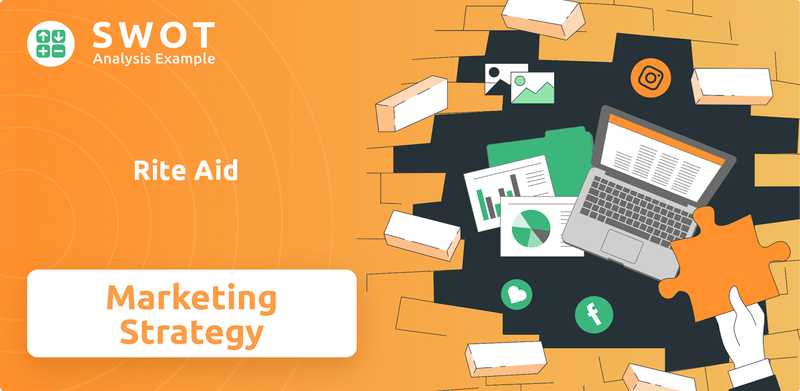
Understanding Rite Aid's Rite Aid SWOT Analysis is crucial to grasping the complexities of its situation. This includes a deep dive into its Rite Aid sales strategy, Rite Aid marketing strategy, and overall Rite Aid business plan. We will explore the company's Rite Aid revenue, Rite Aid market share, and Rite Aid competition to understand its current position and potential future trajectories. Furthermore, we'll dissect its Rite Aid sales and marketing analysis, evaluating Rite Aid marketing campaigns and Rite Aid customer acquisition strategy to provide a comprehensive overview of its past and present.
How Does Rite Aid Reach Its Customers?
The sales and marketing strategy of Rite Aid has evolved, primarily focusing on a blend of online and offline sales channels to reach its customer base. The company's approach has adapted to meet changing consumer expectations, emphasizing convenience and flexibility. This adaptation is reflected in its omnichannel integration strategy, which aims to improve customer experience across all shopping methods.
Rite Aid's sales channels have undergone significant changes, especially concerning its physical retail locations. Initially, physical stores were the primary channel, but the company has reduced its footprint. As of November 2024, Rite Aid operated 1,601 pharmacy locations across the USA. However, by May 2025, this number decreased to approximately 1,245 stores, indicating a strategic realignment. The company is actively pursuing the sale of its assets, including prescriptions and inventory, signaling further adjustments.
Online channels, including a relaunched website and mobile app, have become increasingly important. These digital platforms support prescription management, rewards programs, and online shopping. Rite Aid also provides buy-online-pickup-in-store (BOPIS) options and same-day delivery through partnerships with platforms like Instacart, DoorDash, and Uber Eats. These efforts aim to provide customers with flexibility in how they choose to shop, blending in-store shopping, online orders, and home delivery.
Rite Aid's primary sales channel has historically been its physical retail locations. The company has strategically reduced its physical footprint. As of November 2024, Rite Aid had 1,601 pharmacy locations across the USA. The company's financial difficulties have led to a significant contraction of its physical presence.
Rite Aid has invested in digital capabilities, including a relaunched website and mobile app. These platforms support prescription management, rewards, and online shopping. The company offers buy-online-pickup-in-store (BOPIS) and same-day delivery. These digital channels are crucial for the company's Target Market of Rite Aid.
Rite Aid has partnered with third-party platforms like Instacart, DoorDash, and Uber Eats for same-day delivery. The company introduced flexible payment solutions in all stores through a partnership with Klarna in October 2024. These partnerships are designed to enhance customer convenience and expand service offerings.
Rite Aid is moving toward an omnichannel integration to improve customer experience. The company is focusing on selling off its assets due to financial difficulties. CVS acquired prescription records from over 600 Rite Aid stores and purchased 64 physical locations in Idaho, Oregon, and Washington as of May 2025.
Rite Aid's sales strategy involves a mix of physical and digital channels, adapting to consumer preferences for convenience. The company is streamlining its operations. The company's financial performance has led to significant changes.
- Reduced physical footprint: The company is reducing its number of stores.
- Digital investments: Rite Aid is enhancing its online presence.
- Partnerships: Collaborations with delivery services and payment providers are in place.
- Asset sales: The company is selling assets to manage its financial situation.
Rite Aid SWOT Analysis
- Complete SWOT Breakdown
- Fully Customizable
- Editable in Excel & Word
- Professional Formatting
- Investor-Ready Format
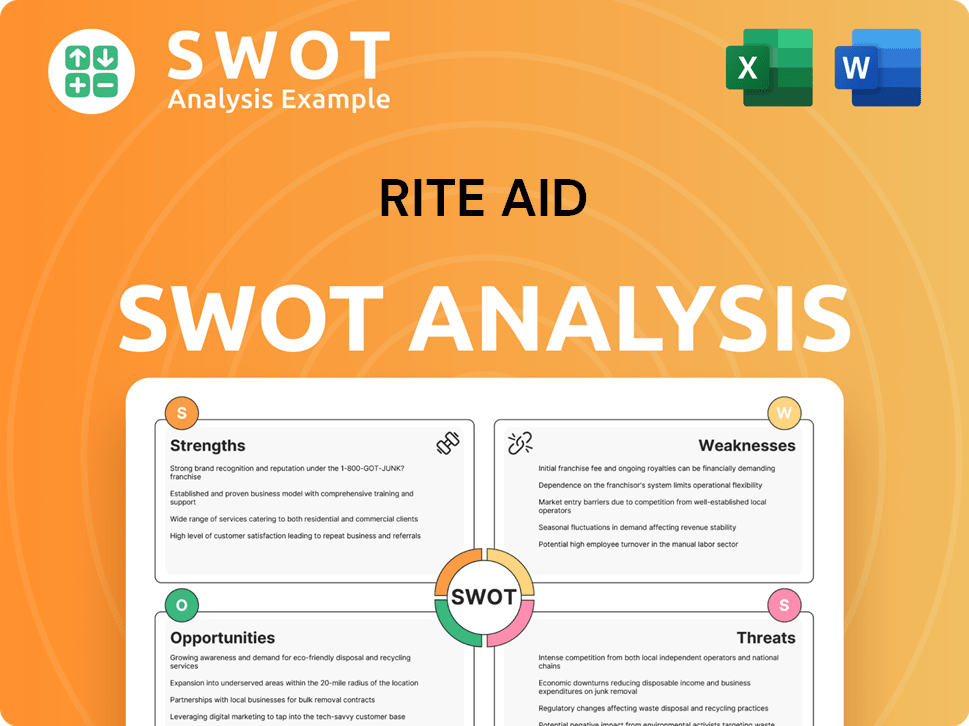
What Marketing Tactics Does Rite Aid Use?
The marketing tactics employed by the company, encompassing both digital and traditional methods, have been crucial in building brand awareness, generating leads, and boosting sales. A key element of their approach is data-driven marketing, which focuses on understanding customer behavior to create personalized experiences and offers. This strategy leverages insights from non-personally identifiable information to tailor loyalty programs and merchandising decisions, enhancing the overall customer experience.
Digital strategies include content marketing, email campaigns, and social media engagement. The company maintains an online presence through its website and mobile app, offering prescription management and online shopping. Partnerships with third-party delivery services such as Instacart, DoorDash, and Uber Eats expand its digital reach. Furthermore, the 'Endless Aisle' program provides an innovative digital solution for product delivery when items are unavailable in-store.
Traditional media, including TV, radio, and print, has likely been part of the marketing mix, although specific details on recent campaigns are limited. The company has focused on customer segmentation and personalization, adapting offerings and pricing strategies to different demographics. The loyalty program, Rite Aid Rewards, which offered points for purchases that could be converted to 'BonusCash,' served as a communication bridge for marketing messages. However, as of May 6, 2025, Rite Aid Rewards points are no longer being issued, and accrued points and BonusCash will expire per standard terms.
The company leverages data to understand customer behavior and tailor personalized experiences. This approach helps in crafting loyalty programs and informing merchandising decisions. In October 2024, the Chief Marketing and Customer Officer emphasized the importance of data.
Digital strategies include content marketing, email marketing, and social media engagement. The company maintains an online presence through its website and mobile app. Partnerships with third-party delivery services like Instacart, DoorDash, and Uber Eats expand its digital reach.
Traditional media usage, such as TV, radio, and print, has likely been part of their marketing mix. The company has focused on customer segmentation and personalization. Specific details on recent campaigns are limited.
The Rite Aid Rewards program offered points for purchases that could be converted to 'BonusCash.' However, as of May 6, 2025, Rite Aid Rewards points are no longer being issued. Accrued points and BonusCash will expire per standard terms.
Technology platforms and analytics tools play a significant role in their data-driven approach. The company has purchased applications like Workday Absence Management, RELEX Automatic Replenishment and Allocation, and Microsoft BI. The marketing mix prioritizes efficiency and strategic investment.
The company adapts offerings and pricing strategies to cater to various customer demographics. This includes strategies for paycheck-to-paycheck consumers. Segmentation is a key part of their Growth Strategy of Rite Aid.
The company's marketing strategy combines digital and traditional approaches, emphasizing data-driven insights to enhance customer engagement and drive sales. This includes leveraging digital platforms and adapting to customer needs.
- Data-driven marketing to understand customer behavior.
- Digital tactics such as content marketing and social media.
- Partnerships with delivery services for wider reach.
- Customer segmentation and personalization of offerings.
- Use of technology and analytics tools for efficiency.
Rite Aid PESTLE Analysis
- Covers All 6 PESTLE Categories
- No Research Needed – Save Hours of Work
- Built by Experts, Trusted by Consultants
- Instant Download, Ready to Use
- 100% Editable, Fully Customizable
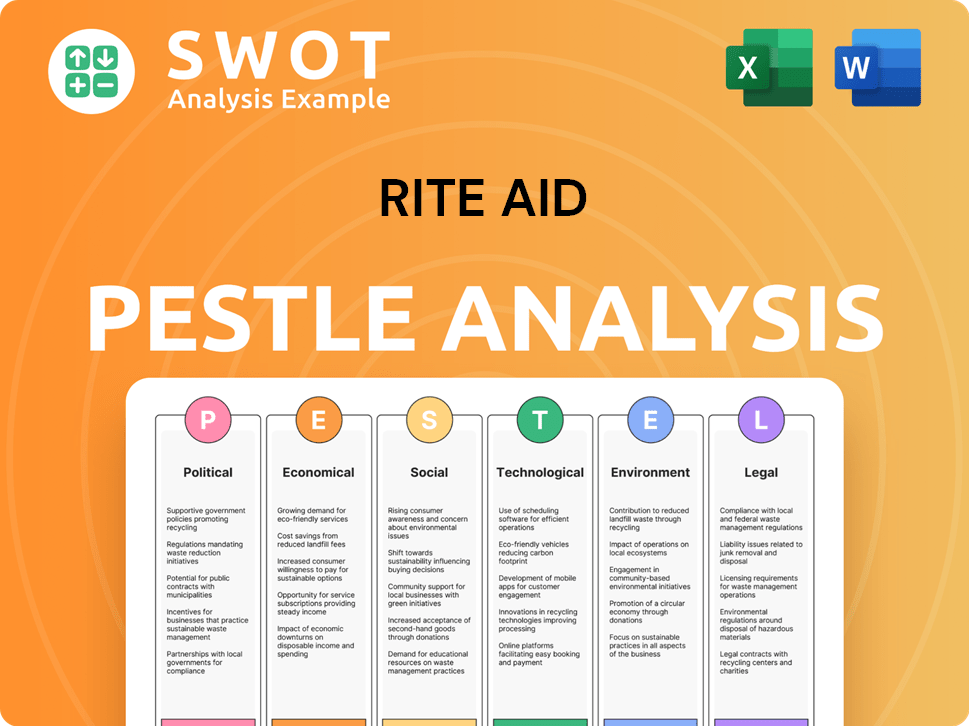
How Is Rite Aid Positioned in the Market?
Historically, Rite Aid positioned itself as a full-service pharmacy, focusing on health outcomes and offering prescription medications, over-the-counter drugs, and health and wellness products. The brand emphasized convenience, quality, and personalized care, aiming to be a one-stop shop for healthcare needs. The company's Rite Aid sales strategy included comprehensive pharmacy services like prescription fulfillment, immunizations, and health screenings.
The core message revolved around helping customers achieve 'whole health for life.' Its visual identity and tone conveyed reliability and community accessibility, supported by numerous locations. Rite Aid targeted a diverse audience, including individuals of all ages and income levels, while also attracting health-conscious consumers through an expanded offering of vitamins, supplements, and wellness products. This approach was a key part of its Rite Aid marketing strategy.
Brand consistency was maintained across physical stores and digital touchpoints, with its website offering prescription refills, product browsing, and health resources. Community engagement through Rite Aid Healthy Futures, which provided nearly $12 million in grants in 2024, aimed to build strong relationships and enhance brand perception. Understanding the Rite Aid target market was crucial for these efforts.
Rite Aid's brand positioning centered on being a trusted source for health and wellness. This included a wide range of products and services, from prescriptions to over-the-counter medications and health-related items. This approach helped differentiate it from some of its Rite Aid competition.
With numerous store locations, Rite Aid aimed to provide convenient access to healthcare products and services. This included extended hours and easy prescription refills, making it a convenient choice for customers. This was a key element of its Rite Aid customer acquisition strategy.
Through initiatives like Rite Aid Healthy Futures, the company demonstrated a commitment to community well-being. These efforts helped build trust and enhance brand perception. The company's community involvement was a part of its overall Rite Aid business plan.
Rite Aid maintained a digital presence through its website, offering prescription refills, product browsing, and health resources. This online presence was crucial for customer engagement. This was part of its Rite Aid digital marketing strategy.
However, recent financial difficulties and a second bankruptcy filing in May 2025 have significantly impacted Rite Aid's brand positioning. The company is now pursuing a sale of substantially all of its assets, and there is skepticism about its future as an independent entity. This shift, with ongoing store closures and the transfer of prescription businesses to competitors, will undoubtedly redefine its brand perception and market presence. For a deeper understanding of the company's financial structure, check out the Revenue Streams & Business Model of Rite Aid.
Rite Aid Business Model Canvas
- Complete 9-Block Business Model Canvas
- Effortlessly Communicate Your Business Strategy
- Investor-Ready BMC Format
- 100% Editable and Customizable
- Clear and Structured Layout
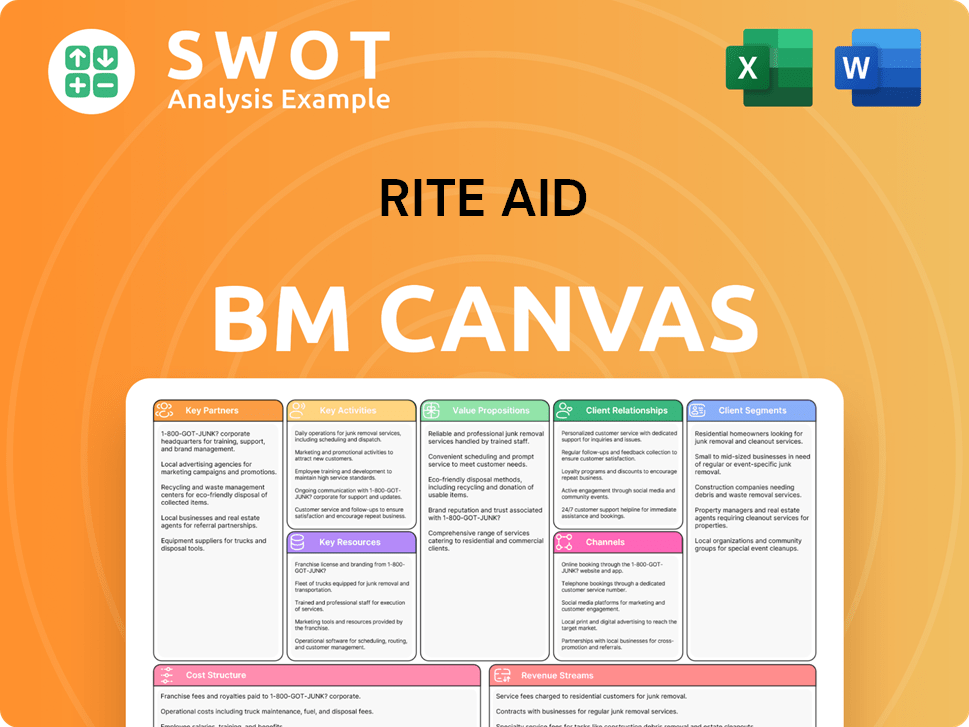
What Are Rite Aid’s Most Notable Campaigns?
The Rite Aid sales strategy has recently been heavily influenced by its financial restructuring and bankruptcy proceedings. The company has been undergoing significant changes, impacting its marketing and sales initiatives. These changes reflect a shift in focus towards stabilizing the business and ensuring operational continuity, particularly in pharmacy services.
Rite Aid marketing strategy has involved several key campaigns, including loyalty programs and digital enhancements. However, the effectiveness of these initiatives has been overshadowed by broader financial challenges. The company's focus has been on asset liquidation and operational adjustments rather than aggressive growth strategies.
The company's approach to Rite Aid business plan is currently centered on navigating bankruptcy and adapting to a changing retail landscape. This has led to a strategic reevaluation of its marketing efforts and a focus on core business functions. The sale of prescription files and store closures highlight a period of significant transition.
The 'Rite Aid Rewards' loyalty program was a key element of the Rite Aid marketing strategy. Members earned points on purchases, which could be converted into 'BonusCash' for future use. However, the program ceased issuing new points on May 6, 2024, indicating a strategic shift amidst financial challenges.
The 'Endless Aisle' program allowed customers to order products online if unavailable in-store. This initiative aimed to improve customer experience through digital and omnichannel access. The program's impact is not publicly detailed, but it reflects an effort to adapt to evolving consumer preferences.
In 2024, Rite Aid Healthy Futures provided nearly $12 million in grants. These grants supported organizations focused on food insecurity, mental health, and racial equity. This initiative aimed to enhance brand visibility and credibility through community support.
Rite Aid experienced a 5% decline in online sales in 2024. This decline, coupled with bankruptcy proceedings, highlights the challenges the company faces. The focus has shifted towards asset liquidation and operational restructuring.
The Rite Aid sales strategy and Rite Aid marketing strategy have been significantly impacted by the company's financial situation. Recent actions include the sale of prescription files to competitors like CVS and Walgreens, indicating a move away from aggressive marketing campaigns and growth initiatives. The primary goal is to maintain pharmacy services during store closures and prescription transfers. For a deeper understanding of the company's origins and development, explore the Brief History of Rite Aid.
- Focus on operational stability.
- Asset liquidation through store closures and sales.
- Prioritizing customer service during transitions.
Rite Aid Porter's Five Forces Analysis
- Covers All 5 Competitive Forces in Detail
- Structured for Consultants, Students, and Founders
- 100% Editable in Microsoft Word & Excel
- Instant Digital Download – Use Immediately
- Compatible with Mac & PC – Fully Unlocked
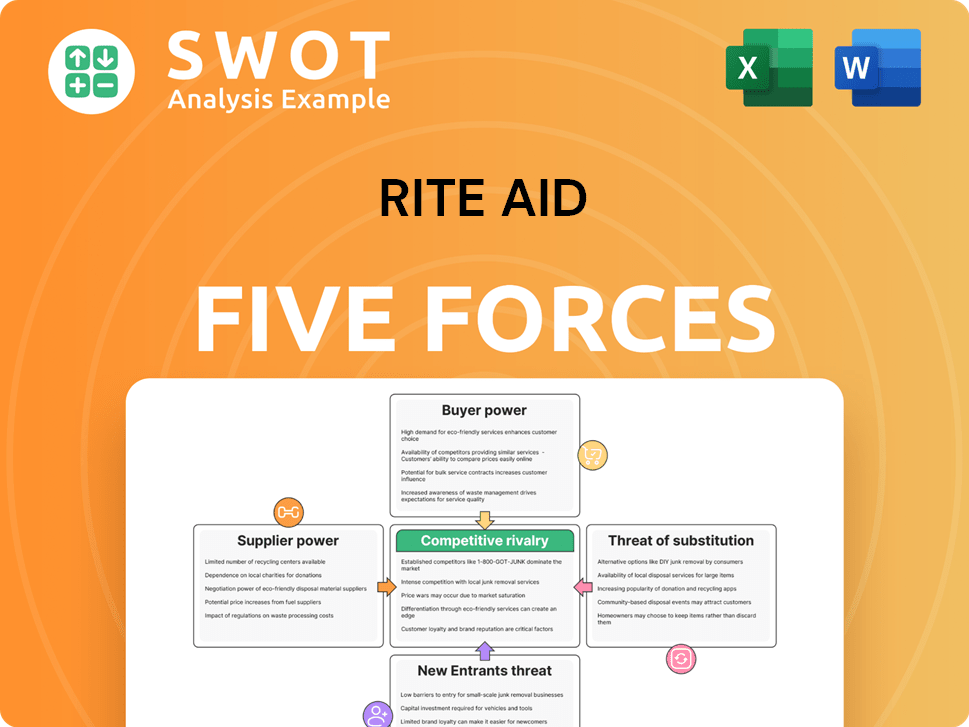
Related Blogs
- What are Mission Vision & Core Values of Rite Aid Company?
- What is Competitive Landscape of Rite Aid Company?
- What is Growth Strategy and Future Prospects of Rite Aid Company?
- How Does Rite Aid Company Work?
- What is Brief History of Rite Aid Company?
- Who Owns Rite Aid Company?
- What is Customer Demographics and Target Market of Rite Aid Company?
Disclaimer
All information, articles, and product details provided on this website are for general informational and educational purposes only. We do not claim any ownership over, nor do we intend to infringe upon, any trademarks, copyrights, logos, brand names, or other intellectual property mentioned or depicted on this site. Such intellectual property remains the property of its respective owners, and any references here are made solely for identification or informational purposes, without implying any affiliation, endorsement, or partnership.
We make no representations or warranties, express or implied, regarding the accuracy, completeness, or suitability of any content or products presented. Nothing on this website should be construed as legal, tax, investment, financial, medical, or other professional advice. In addition, no part of this site—including articles or product references—constitutes a solicitation, recommendation, endorsement, advertisement, or offer to buy or sell any securities, franchises, or other financial instruments, particularly in jurisdictions where such activity would be unlawful.
All content is of a general nature and may not address the specific circumstances of any individual or entity. It is not a substitute for professional advice or services. Any actions you take based on the information provided here are strictly at your own risk. You accept full responsibility for any decisions or outcomes arising from your use of this website and agree to release us from any liability in connection with your use of, or reliance upon, the content or products found herein.